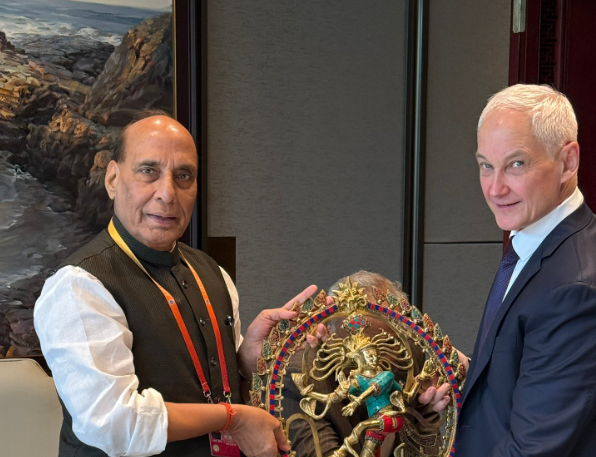
In the glittering city of Qingdao, China — often hailed as a symbol of modern development — the real spotlight at the 2025 Shanghai Cooperation Organization (SCO) defense ministers’ meeting was on India. Specifically, it was on India’s Defence Minister Rajnath Singh, whose speech turned into a diplomatic thunderclap. This was not just another diplomatic statement. It was a bold, direct, and strategic warning aimed at Pakistan, delivered in front of a global audience and, notably, in front of Pakistan’s own Defence Minister.
This visit was significant in itself. It marked the first visit by an Indian Defence Minister to China since the 2020 Ladakh border standoff, signaling not just a thaw in optics, but a change in tone. India’s posture was clear and unambiguous. As Rajnath Singh began his address, the world was listening — but Pakistan was holding its breath.
The focus of Singh’s message was terrorism — and how it continues to threaten peace and prosperity across the region. Without naming Pakistan directly, he held terror-sponsoring nations accountable, saying:
“Peace and prosperity cannot coexist with the threat of terrorism or the proliferation of weapons of mass destruction by non-state actors.”
This was a thinly veiled reference to Pakistan, known for supporting cross-border terrorism. The implication was crystal clear: those who provide safe havens, weapons, or diplomatic cover to terrorist groups will be held responsible. And this message was being delivered while Pakistan’s Defence Minister sat in the same room — a diplomatic move as precise as a missile strike.
Singh referenced the April 22, 2025 terror attack in Pahalgam, Jammu & Kashmir, carried out by The Resistance Front (TRF). He made it clear that the attack wasn’t random — it was premeditated profiling based on religious identity. TRF, a known proxy of Lashkar-e-Taiba, has long been supported by Pakistan. By drawing this connection on the SCO stage, India effectively exposed Pakistan’s dual game in front of major powers like Russia and China.
He went further, saying:
“India has shown that the epicenters of terrorism are not safe anymore. We have targeted them and will not hesitate to do so again.”
This wasn't just a reminder of India’s past military actions like the Balakot strike; it was a strategic red flag to Pakistan’s terror infrastructure. The message was straightforward: India will not tolerate terrorism — and it will respond, decisively.
Singh also highlighted emerging terror tactics, particularly the use of drones to smuggle arms and drugs across borders. These methods — widely attributed to Pakistan's involvement along the Punjab and Jammu & Kashmir borders — represent a new, hybrid form of terrorism. He called for international cooperation, stating that traditional borders are no longer sufficient safeguards.
Taking a broader view, Rajnath Singh said:
“No country, however powerful, can ensure global security alone.”
This was a global appeal, and while it had regional undertones for China and Pakistan, it also positioned India as a rising global power — one that supports collective peace and security but on its own terms.
He didn’t stop at Pakistan. Singh also took aim at SCO’s own double standards, urging the organization to stop shielding or tolerating states that use terrorism as state policy. He challenged SCO to shed its silence and hold such countries accountable, even if they are members.
Singh concluded with a powerful reflection of India’s civilizational ethos:
“For us, Sarve Santu Niramayah — may all be happy and free from suffering — is not just a shloka; it is our global vision.”
This was a clear message of strength combined with peace. India seeks peace not from weakness, but from a position of power. India is no longer the country that quietly watches from the sidelines. It engages, asserts, and leads.
At SCO 2025, India didn’t just attend. It dominated — diplomatically and ideologically. In China's own backyard, Pakistan was diplomatically isolated, terrorism was named and shamed, and India’s voice rang loud and clear.
Disclaimer:
This article is based on publicly available information and official statements. The interpretations reflect the stance projected by Indian authorities and may differ from other perspectives.




